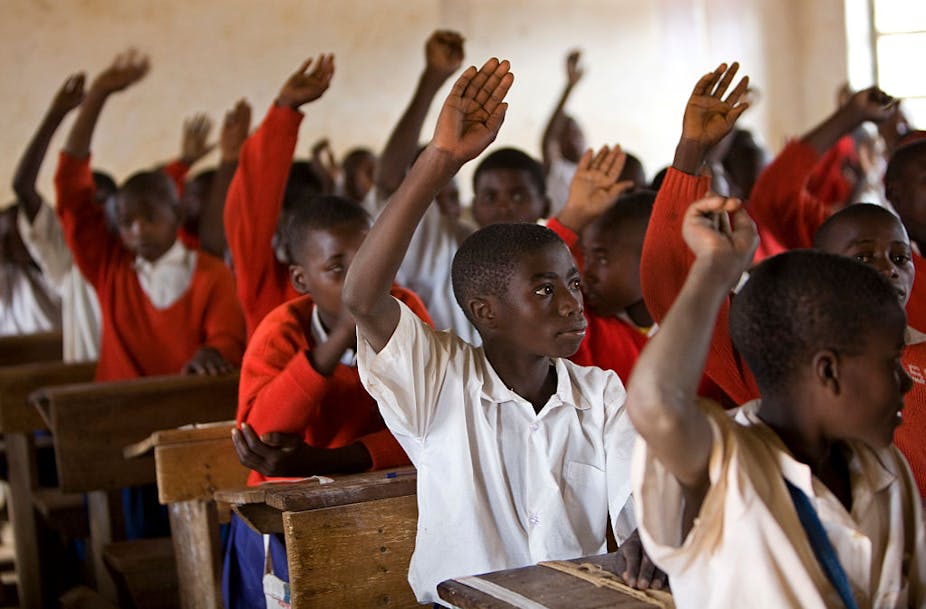Soon after independence from Britain in 1961, Tanzania declared war on three main obstacles to its development goals – ignorance, disease and poverty. Well ahead of other African countries, Tanzania introduced a universal primary education programme in 1974 in keeping with its “education for self-reliance” policy.
But this was an uphill task for Tanzania’s new government. It’s estimated that 85% of the population was illiterate and extremely poor. Hunger, widespread disease and a low average life expectancy of just above 40 years, were also major obstacles. Periodic droughts, food shortages and limited access to international aid further complicated matters.
By necessity, the rural population – which made up 90% of the population – would be the driver of the new economy. Yet they were so scattered that it was difficult to extend the social services needed to improve their living conditions and agricultural productivity.
This was the reality in which the government, with the support of NGOs, sought to re-design the educational system to expand its literate work force. Adult education in the 1960s and 1970s emphasised self development and community development. These programmes taught literacy, numeracy, nutrition, hygiene and agricultural practices.
Provision of education was also guaranteed in the constitution as a basic human right. Overall, there has been tremendous progress in the numbers of children enrolled in schools over the last two decades.
In 2020, 10.9 million pupils – an increase of 39% – were enrolled in Grade 1 following the removal of school fees. But access to pre-primary education is very low. Infrastructural facilities are largely inadequate and there’s an acute shortage of qualified pre-primary school teachers in public schools across the country. The ratio of pupils to qualified teachers at early grades is also significantly low in rural schools.
Recently, Tanzania instituted a school re-entry policy. It states that all students who drop out of school due to various reasons such as truancy, disciplinary issues or pregnancy should be allowed to return to school.
This initiative is part of an effort by the Tanzanian government to increase education rates among the population. It also aims to close the gender gap in education by addressing barriers to education.
Completion rate
Students who completed secondary school reported to be at 29.57% (of the relevant age group) in 2018. Despite the remarkable progress over the past few decades, challenges remain in reducing regional disparities and inequalities among secondary school-age students from different socio-economic backgrounds.
Progress has been aided in no small way by Tanzania’s decision to prioritise the use of Kiswahili as a language of instruction in schools. Research has proved time and again that lack of familiarity with the language of instruction is a big barrier, especially in the early years of schooling.
Education for self reliance
The 1967 Arusha Declaration has had a telling effect on Tanzania’s educational policies since independence. It sought to reduce the income inequality among all citizens and shift development efforts towards rural areas. Its objective was to ensure equal access for all socio-economic groups.
To this end, the government took control of all private educational institutions previously owned by Christian missionaries and other religious organisations. The entire population was mobilised towards achieving universal literacy in a short period. This was done through media and by involving the ruling party and government leaders through public campaigns and volunteerism. Expansion of enrolment was immediate as over-age children seized this opportunity to enrol.
Nevertheless poverty remains an important factor in the provision of quality education. Economically marginalised Tanzanian families still resort to early marriages and child labour. Poverty makes it less likely that children will complete their education. Many rural families also entirely depend on subsistence agriculture to meet their basic needs.
In addition, children with albinism are vulnerable to attack, mutilation and murder. They will continue to be excluded from education unless their rights to freedom from discrimination, to an adequate standard of living and to meaningful education participation are guaranteed.
What should be done?
What Tanzania still needs to do in order to achieve quality and inclusive education is to prioritise disadvantaged and marginalised children in schools. They need support services and appropriate learning facilities.
The education budget also needs attention. Tanzania’s education sector accounts for 15% of the total budget. It’s 3.9% of the country’s gross domestic product. This falls short of the Global Partnership for Education target, which encourages countries to commit at least 20% of the national budget to education. Education receives a lower proportion of state funding compared to other sectors of the economy such as infrastructural development.
School feeding programmes are crucial to improve enrolment and attendance. But they are not in place across the country. Feeding programme costs should also be captured in the national budget to ensure all students get meals during school hours to address truancy and dropouts.
What’s needed is a human rights-based approach with commitment to recognising and respecting the rights of children while they are attending school. This includes respect for their identity, agency and integrity. This would help to increase retention rates and make the process of education empowering, participatory, transparent and accountable.

